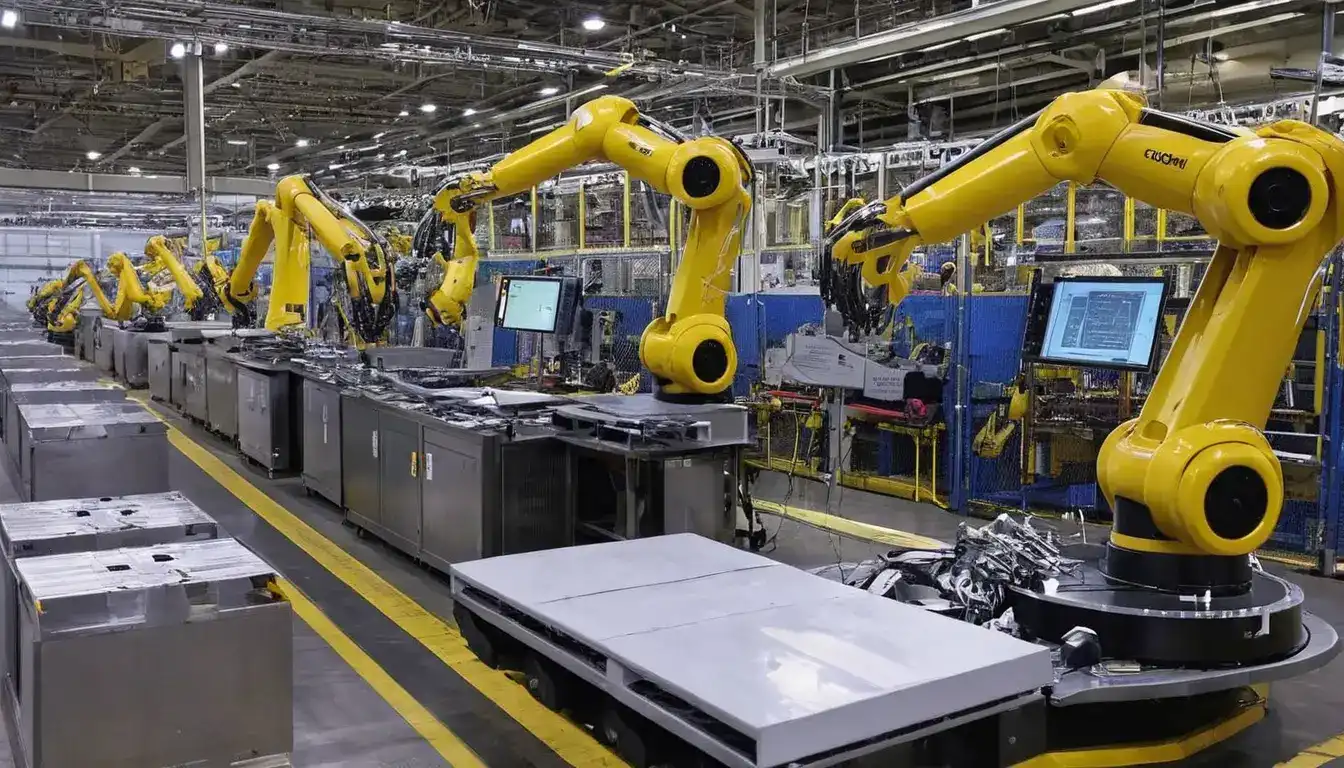Tech Transforms Education: Beyond Classroom Walls
Emily Willis

Photo: Tech Transforms Education: Beyond Classroom Walls
Tech Transforms Education: Learning Beyond Classroom Walls
Remember the days of chalkboards, textbooks, and rigid class schedules? For many, that's still the picture that comes to mind when they think about education. But in our rapidly evolving world, technology in education is breaking down those traditional barriers, ushering in an exciting era where learning truly happens beyond classroom walls. This isn't just about adding computers to schools; it's about a fundamental shift in how, where, and when we learn, making education more accessible, personalized, and engaging for everyone.
The global EdTech market is projected to reach an astounding US$598.82 billion by 2032, with an annual growth rate exceeding 17%, indicating a significant and ongoing transformation in how we teach and learn. This article will explore how tech transforms education, highlighting the innovative ways digital tools are reshaping learning, fostering lifelong skills, and addressing the challenges that come with this exciting revolution.
The Digital Classroom: Learning Anytime, Anywhere
One of the most profound impacts of technology in education is the rise of online learning. No longer confined to physical buildings, education has become incredibly flexible and accessible.
Embracing Online Learning and Flexibility
Online learning platforms have democratized education, offering unparalleled flexibility. Students can participate in high-quality learning experiences even when distance or schedule conflicts make traditional schooling difficult or impossible. This means learning can happen from virtually anywhere in the world, as long as there's an internet connection.
- Accessibility: Online courses remove geographical barriers, allowing individuals in remote areas or those with physical limitations to access education.
- Flexibility: Many online programs offer asynchronous learning, meaning students can access lectures and materials 24/7, fitting their studies around work, family, and other responsibilities. This self-paced approach can reduce stress and prevent burnout.
- Increased Variety: Students aren't limited to courses offered locally; they can enroll in a wide range of subjects from institutions globally, expanding their educational options.
This flexibility is particularly beneficial for college students who often balance work and studies, allowing them to continue their jobs while pursuing their degrees.
Personalized Learning: Tailoring Education to You
The "one-size-fits-all" approach to education is quickly becoming a relic of the past, thanks to advancements in ed-tech tools and Artificial Intelligence (AI).
AI-Driven Adaptive Learning Systems
AI is a transformative force in personalized learning, creating adaptive learning platforms that adjust content and teaching methods based on an individual student's profile. These platforms analyze student data to track progress, identify strengths and weaknesses, and dynamically adjust the curriculum, providing tailored content and individualized pacing.
- Customized Pathways: AI can provide students with personalized learning routes that align with their objectives, interests, and prior knowledge. This ensures students receive the right challenges and support, maximizing learning outcomes.
- Instant Feedback and Assessment: AI-powered systems can automate evaluation and provide immediate, individualized feedback on assignments, tests, and quizzes. This helps students understand their mistakes and reinforces learning.
- Intelligent Tutoring Systems (ITS): AI-powered virtual tutors and chatbots offer instant support, answering queries, providing explanations, and guiding students through difficult concepts 24/7.
This focus on individual needs enhances engagement, motivation, and ultimately, learning outcomes.
Immersive Experiences: Bringing Learning to Life
Virtual reality education (VR) and augmented reality (AR) are revolutionizing how students interact with content, moving beyond passive consumption to truly immersive experiences.
Virtual Reality and Augmented Reality in Education
VR and AR enhance learning by offering memorable, hands-on experiences that allow students to refine skills in a safe environment. They immerse students in virtual environments that simulate real-world scenarios, allowing interaction with digital objects and characters.
- Virtual Field Trips: Platforms like Google Expeditions and Discovery VR allow students to explore global landmarks, natural wonders, and historical sites without leaving the classroom. Imagine visiting ancient ruins or traveling to outer space!
- Medical and STEM Training: Medical students can practice surgeries and procedures in a safe, controlled virtual environment. Science students can interact with digital simulations of complex concepts like molecular structures or the human body, or conduct virtual lab experiments without costly equipment.
- Language and Cultural Immersion: VR can simulate everyday conversational situations, allowing language students to practice speaking and listening skills in virtual environments that mimic real-life scenarios, like a language cafe in Madrid. It can also bring cultural festivals to life.
- Historical Simulations: Students can be transported back in time to experience historical events or interact with historical figures, making history more engaging and memorable.
These technologies make abstract ideas more tangible, capture attention, and spark curiosity, leading to deeper engagement and knowledge retention.
Gamification and Engagement: Making Learning Fun
Engaging students is key to effective learning, and ed-tech tools are leveraging the power of play to achieve this.
The Power of Gamified Learning
Gamification incorporates game-like elements into educational settings, making learning interactive, motivating, and fun. This approach has long been recognized for its ability to engage students.
- Interactive Quizzes and Challenges: Tools like Kahoot!, Quizzizz, and Quizlet offer competitive quizzes and interactive content that provide instant feedback and make learning enjoyable.
- Leaderboards and Rewards: These elements tap into students' natural competitive spirit, encouraging participation and mastery of concepts.
- Skill Development through Play: Educational games can help develop practical skills, such as anatomy-based video games for medical students.
Studies show that students using digital learning tools demonstrate improved test scores, with one Stanford University research indicating a 12% improvement compared to traditional methods. Another report found that 76% of students say technology makes learning more engaging.
Collaboration and Global Connectivity: Breaking Down Barriers
Technology fosters a connected learning environment, transcending geographical boundaries and promoting teamwork.
Connecting Learners Across the Globe
Digital tools facilitate collaboration and community building among learners, enabling knowledge sharing and peer-to-peer learning.
- Collaborative Platforms: Tools like Google Docs and other cloud-based solutions allow students to work together on projects in real-time, regardless of their physical location.
- Virtual Breakout Rooms and Forums: Online learning environments offer opportunities for dynamic interaction between instructors and students, and among students themselves, through message boards, live chats, and video conferencing.
- Global Classrooms: Students can connect with peers and experts from around the globe, fostering diverse perspectives and cultural understanding.
This global connectivity prepares students for an interconnected world, emphasizing crucial 21st-century skills like communication and collaboration.
AI and Analytics for Educators: Empowering Teachers
Technology in education isn't just for students; it's also a powerful ally for educators, streamlining tasks and providing valuable insights.
Data-Driven Insights and Teacher Support
AI and learning analytics tools are transforming how teachers manage their classrooms and support student learning.
- Automated Grading and Feedback: AI can automate the grading process for assignments, quizzes, and tests, providing teachers with more time to focus on instruction.
- Identifying Learning Gaps: AI algorithms can analyze large amounts of student data to predict performance, identify patterns in mistakes, and pinpoint areas where students need additional support. This allows teachers to tailor their instruction effectively.
- Lesson Planning and Content Creation: Generative AI can act as a personal assistant for teachers, helping them plan lessons creatively, curate content, and even assist with administrative tasks like managing schedules and communicating with parents.
By leveraging these tools, teachers can enhance their productivity, personalize learning opportunities, and gain deeper insights into student progress.
Navigating the Digital Frontier: Challenges and Considerations
While tech transforms education in incredible ways, it's essential to acknowledge and address the challenges that come with this shift.
Overcoming Obstacles in EdTech Integration
Integrating technology effectively into education presents several hurdles that need careful consideration.
- The Digital Divide: Unequal access to reliable internet and devices remains a significant concern, particularly in underserved communities. This can lead to disparities in educational opportunities.
- Teacher Training and Professional Development: New technology is only useful if teachers know how to use it effectively. Many educators lack adequate training and ongoing support to integrate digital tools into their teaching practices.
- Data Privacy and Security: As more student data is collected digitally, protecting sensitive personal information from breaches and unauthorized use becomes paramount.
- Screen Time and Well-being: Concerns about excessive screen time and its potential impact on students' physical and mental health are valid and require thoughtful strategies for balance.
- Maintaining Human Connection: While technology offers many benefits, it's crucial to ensure that the human element of teaching—mentorship, social interaction, and emotional support—remains central to the learning experience.
Addressing these challenges requires strong leadership, investment in infrastructure and training, clear integration strategies, and ongoing support for both educators and students. [10, 11, 1
Latest ✨
View Allcreating engaging content to attract and retain customers in the digital age. It provides strategies for understanding the audience, setting content goals, creating high-quality content, using storytelling and emotional connection, and optimizing content for conversions. It also covers content formats and distribution, measuring and analyzing content performance, and building relationships with influencers and user-generated content.
Emily Willis
Rediscover the power of play! It's not just for kids—it's the secret to unlocking future learning, essential skills, and human potential at every age.
Emily Willis
Unlock startup success! Learn the key differences between business incubators and accelerators. Discover which support system is ideal for your venture's growth...
Emily Willis
The world of work is changing rapidly due to automation, AI, and technological advancements. While some fear widespread unemployment, the reality is more nuanced. The future of work is about humans adapting, reskilling, and exploring new market opportunities. Automation is increasing efficiency and reducing costs, but also shifting the job landscape.
Emily Willis
Business
View All
August 5, 2024
5 Keys to Success in Starting a New Business in the Digital AgeThe digital age has brought both opportunities and competition to the business landscape. To succeed in this environment, it is important to identify market needs, develop a unique value proposition, build a strong online presence, embrace technology and data-driven decision making, prioritize customer experience, and foster a culture of innovation and adaptability.
Emily Willis

June 9, 2025
Succeed with SaaS Business ModelMaster the SaaS business model! This guide reveals strategies for building a thriving enterprise, from understanding the landscape to achieving product-market f...
Emily Willis

June 9, 2025
Step-by-Step Business RegistrationsNew business? Discover why registration is vital for legal protection, credibility, and funding. Our guide simplifies establishing your venture.
Emily Willis
Economy
View AllBeyond crypto hype: Understand digital asset economics. Learn core principles like supply, demand, scarcity & utility to navigate the market wisely.
Read MoreDemystify Forex trading. Discover its vast opportunities and navigate its inherent risks in the world's largest financial market.
Read MoreDiscover the foundations of banking stability. Learn how strong regulations, capital, deposit insurance, and technology build a resilient financial sector.
Read MoreEntertainment
View All
August 4, 2024
Profiles of Famous Artists Who Inspire the Younger Generationthe inspirational aspects of famous artists such as Vincent van Gogh, Frida Kahlo, Pablo Picasso, Banksy, Yayoi Kusama, Jean-Michel Basquiat, Georgia O'Keeffe, Andy Warhol, Kehinde Wiley, and Ai Weiwei. It highlights their perseverance, innovation, authenticity, social commentary, mental health advocacy, and representation, among other qualities, and how these aspects continue to inspire young artists to pursue their creative dreams.
Emily Willis

August 4, 2024
The Latest Music Trends, Artists Influencing Pop Culture, and How Digital Platforms Facilitate the Distribution of Music GloballyThe music industry is constantly changing due to consumer preferences, technology, and the influence of artists. Digital platforms have revolutionized music creation, distribution, and consumption, leading to genre fusion, the rise of independent artists, and collaborative projects. Influential artists like Billie Eilish, BTS, and Taylor Swift have shaped pop culture globally. Streaming services, social media, and direct-to-fan engagement have transformed music distribution. Digital platforms also promote cultural diversity and inclusivity, expand markets and revenue, and drive technological advancements. The industry is also focusing on sustainability and ethical practices. To succeed in the future, stakeholders must embrace digital transformation and champion inclusivity.
Emily Willis

August 5, 2024
Video Games: Enduring Appeal, Immersive Worlds, and Diverse Genresenduring appeal of video games, highlighting their ability to transport players to fantastical realms, challenge their minds, and foster connections with others. It explores the magic of immersive worlds, the vast array of genres available, and the social power of gaming.
Emily Willis
Health
View AllQuality sleep is essential for overall health and well-being, impacting physical, cognitive and emotional functioning. Lack of quality sleep can lead to a variety of health issues, including weakened immune function, heart problems, weight gain and cognitive impairment.
Emily Willis
Maintaining good health involves a balanced diet that provides essential nutrients for the body. A balanced diet includes carbohydrates, proteins, fats, vitamins, minerals, fiber, and water. Benefits of a balanced diet include enhanced energy levels, improved mental health, a stronger immune system, better weight management, reduced risk of chronic diseases, and enhanced digestion. Components of a balanced diet include fruits and vegetables, whole grains, protein sources, dairy or dairy alternatives, and healthy fats. Tips for maintaining a balanced diet include planning meals, portion control, staying hydrated, limiting processed foods, eating mindfully, and including physical activity.
Emily Willis
Regular physical activity is crucial for maintaining long-term health and well-being. It has numerous benefits, including improving cardiovascular health, aiding in weight management, enhancing mental health, strengthening bones, boosting immune function, and promoting longevity.
Emily Willis
Trending 🔥
View All
1
2
4
5
6
7
8
9
10
Lifestyle



Sports
View AllAugust 5, 2024
Sportsmanship in the Spotlight: Cultivating Respect, Integrity, and Ethical Behavior
Read MoreTechnology
View All
August 4, 2024
The Rise of Blockchain Technology: Applications Beyond Cryptocurrency
Blockchain technology, initially associated with cryptocurrencies, has expanded to have diverse applications across industries. It is a decentralized digital ledger that ensures secure, transparent, and immutable transactions. Beyond cryptocurrency, blockchain has been applied to supply chain management, healthcare, voting systems, smart contracts, digital identity verification, real estate transactions, and supply chain finance. Future trends include enhancing interoperability, addressing scalability issues, and exploring regulatory frameworks. Overall, blockchain technology has the potential to revolutionize various sectors by enhancing efficiency, security, and trust in operations.

August 5, 2024
Best AR Apps for Interior Design
Discover the top AR apps for interior design and transform your space with ease! From furniture placement to paint colors, these innovative tools will revolutionize the way you decorate, making your home design dreams a reality

August 5, 2024
AI Trend Predictions for 2024 and beyond
AI is no longer a futuristic concept, it is shaping our world at an unprecedented pace. In 2024 and beyond, AI trends are likely to dominate in various industries. Generative AI is expected to revolutionize content creation, design, and product development. In healthcare, AI will lead to personalized medicine, drug discovery acceleration, improved diagnostics, and remote patient monitoring.

August 4, 2024
AI-Powered Robots Take Over Manufacturing Jobs: Is Our Workforce Prepared?
AI-powered robots are transforming the manufacturing industry, leading to increased efficiency and improved product quality. While concerns about job displacement exist, AI is more likely to transform jobs rather than eliminate them.


















